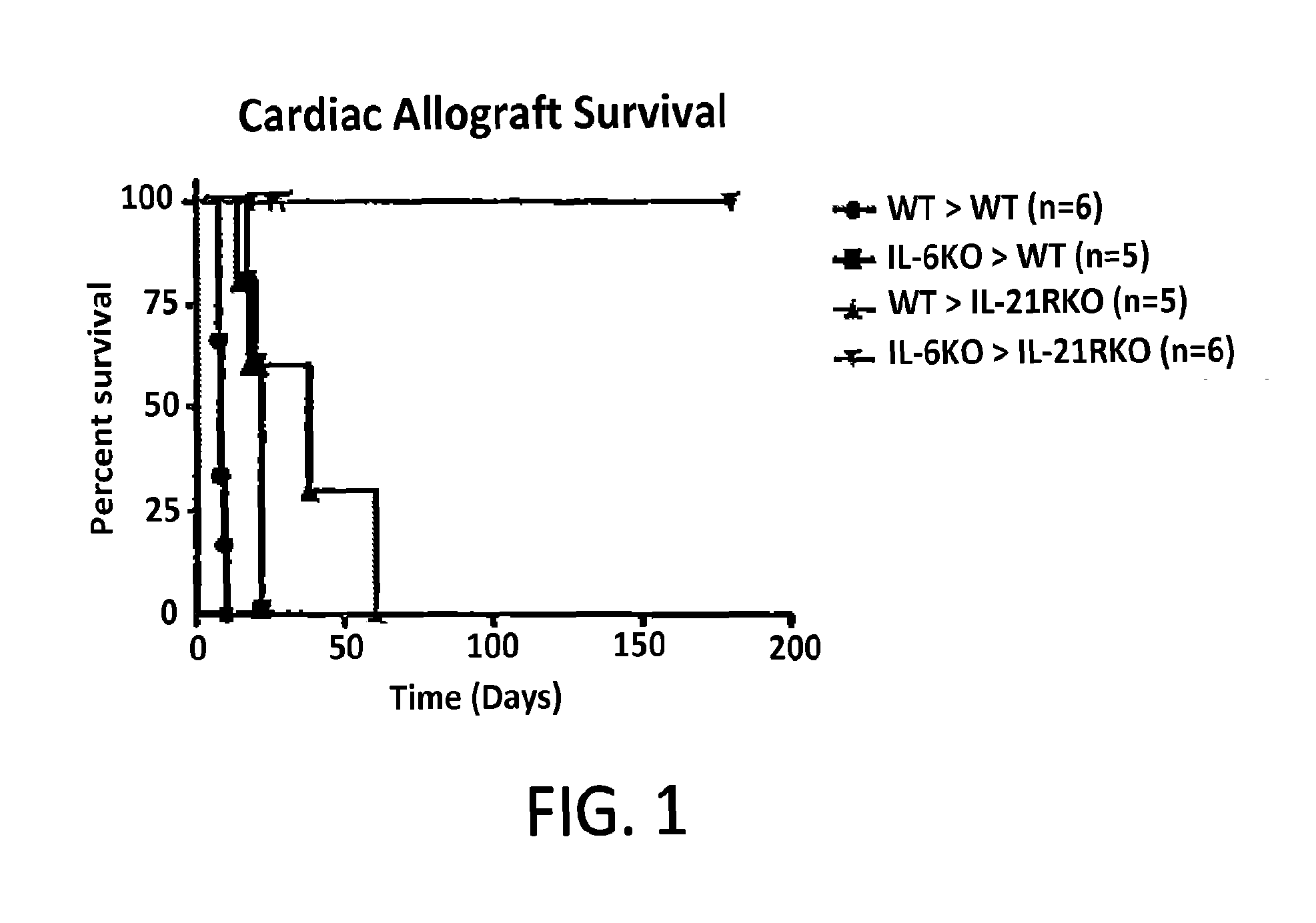Compositions and methods featuring il-6 and il-21 antagonists
a technology of il-6 and il-21, which is applied in the field of compositions and methods for modulating the immune response, can solve the problems of loss of graft function, graft damage due, and simply unacceptable results
- Summary
- Abstract
- Description
- Claims
- Application Information
AI Technical Summary
Benefits of technology
Problems solved by technology
Method used
Image
Examples
examples
[0117]We have successfully bred IL-6 knockout (KO) and IL-21 receptor (IL-21R) KO mice into both C57BL / 6 and Balb / c backgrounds and also crossed them with C57BL / 6 and Balb / c foxp3gfp knockin mice enabling precise tracking of Foxp3+Tregs based on their expression of green fluorescent protein. These genetically altered mice are within the scope of the present invention; they are an aspect of the invention. While the IL-6 blocking antibodies are available commercially, we developed the mutant antagonist-type IL-21.Ig. This antagonist is also within the scope of the present invention; it is an aspect of the invention. The mutant of IL-21 (mIL-21) binds to the cytokine-specific α subunit, but not to the common γ-chain component of the IL-21 receptor complex, and thus fails to activate down-stream JAK-STAT signaling. As noted above, IL-21 consists of 131 amino acids that form a four-helix bundle and exhibit homology with IL-2, IL-4, IL-7 and IL-15. The antagonist, mutant of IL-21 (mIL-21)...
example 2
IL-6 Promotes Accelerated Islet Allograft Rejection by Destroying Both nTreg and iTreg Compartments and Tilting the Balance Between Treg / TH17
[0138]In Vivo Imaging.
[0139]We have developed a “color-coded” adoptive transfer model for T cell subset identification that enables serial analysis of islet allograft infiltrating yellow induced regulatory T cells (iTreg), green natural regulatory T cells (nTreg) and red effector T cells (Teff) in live animals using endoscopic confocal microscopy (Nat. Med. 2010). Using this model, we found that delivery of IL-6 in this model via osmotic pumps promoted accelerated allograft rejection (FIG. 4,5). The IL-6 triggered accelerated allograft rejection was associated with inhibition of conversion of naive CD4+ T cells to iTreg as well as the loss of nTreg phenotype. Flow cytometry analysis based on incorporation of CD45.1 congenic marker into the model demonstrated that the majority of nTreg converted to either Th17 or Th1 phenotype post allograft tra...
example 3
[0140]We evaluated cardiac allograft tissue using tissue injury markers hematoxylin and eosin stain (“H&E”), Caspase 3,4-hydroxynonenal (membrane lipid peroxidation) and 8-Hydroxy-2′-deoxyguanosine (DNA damage). We monitored immune cell infiltrates using the following markers: CD4, CD8, CD11b, Foxp3 and NKp46. We will also monitor immune call infiltrates using CD45, CD3, RORgt, IL-17A, Tbet, GrzB, CD11b, CD69, CD11c, CD44, Gr1, F4 / 80, B220 and TIM4.
[0141]A number of embodiments of the invention have been described. Nevertheless, it will be understood that various modifications may be made without departing from the spirit and scope of the invention. Accordingly, other embodiments are within the scope of the following claims.
PUM
| Property | Measurement | Unit |
|---|---|---|
| length of time | aaaaa | aaaaa |
| weight | aaaaa | aaaaa |
| median survival time | aaaaa | aaaaa |
Abstract
Description
Claims
Application Information
 Login to View More
Login to View More - R&D
- Intellectual Property
- Life Sciences
- Materials
- Tech Scout
- Unparalleled Data Quality
- Higher Quality Content
- 60% Fewer Hallucinations
Browse by: Latest US Patents, China's latest patents, Technical Efficacy Thesaurus, Application Domain, Technology Topic, Popular Technical Reports.
© 2025 PatSnap. All rights reserved.Legal|Privacy policy|Modern Slavery Act Transparency Statement|Sitemap|About US| Contact US: help@patsnap.com



